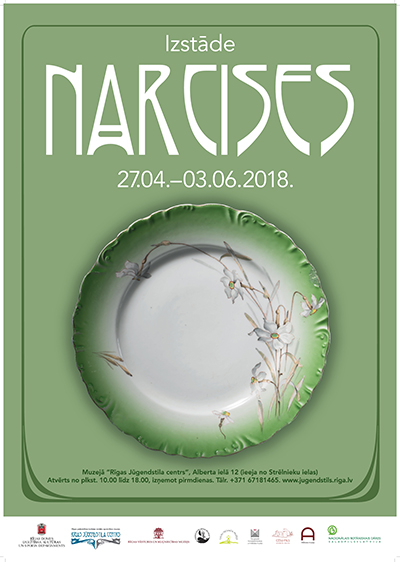


The exhibition has been created in cooperation with Riga Museum of History and Navigation, Jūrmala City Museum, Talsi Municipality Museum, Local History and Art Museum of Daugavpils, Cēsis Castle Complex, Alūksne Museum, National Botanical Garden in Salaspils and private collections.
Many people in the world are familiar with the myth by Ovid about a handsome young man Narcissus who, when seeing his own reflection on the water surface, fell in love with it. Many world- famous artists have depicted the myth in their work. The sad story, however, has not reduced the popularity of the daffodil as a flower. In Latvia, daffodils do not grow in wild, but we are fond of having them in our gardens. Because of its fine and lissom line the flower has been widely used in the art nouveau art and household items. In the “Daffodils” exhibition of the museum “Riga Art Nouveau Centre” there are under a hundred exhibits featuring among them outstanding samples where the decoration has been inspired by this flower. The daffodil as a spring flower is often shown together with willow catkins, tulips, forget-me-nots and other plants. The exhibition also features a mirror decorated with two trumpet-like daffodils manufactured at the beginning of the 20th century in the Plewkiewicz company in Poland. It was presented to somebody in 1916 with an inscription “In remembrance from Lina”. The cup and saucer from J.Jaksch&Co painter workshop decorated with the yellow bloom of daffodils stand out with a particularly fine manual painting and gilding. “Poet’s Daffodils” (Narcissus poeticus) adorn the plate manufactured at M.S.Kuznetsov Porcelain Factory at the end of the 19th and beginning of the 20th century. These are among the first cultivated daffodils therefore they are often associated with the antique world. The museum collection features a large number of postcards and greeting cards with daffodil flowers. It is interesting that daffodil flowers commonly appear on Confirmation cards.
During the exhibition – on 26 May at 14:00 there will be a class of botanical drawing. The smallest visitors of the museum will have colouring sheets with daffodil motifs available for the whole length of the exhibition.
A particular addition to the souvenir collection of the museum is a mug the decorative element of which – a daffodil – has been borrowed from a current exhibit – a tray dating back to the beginning of the 20th century.